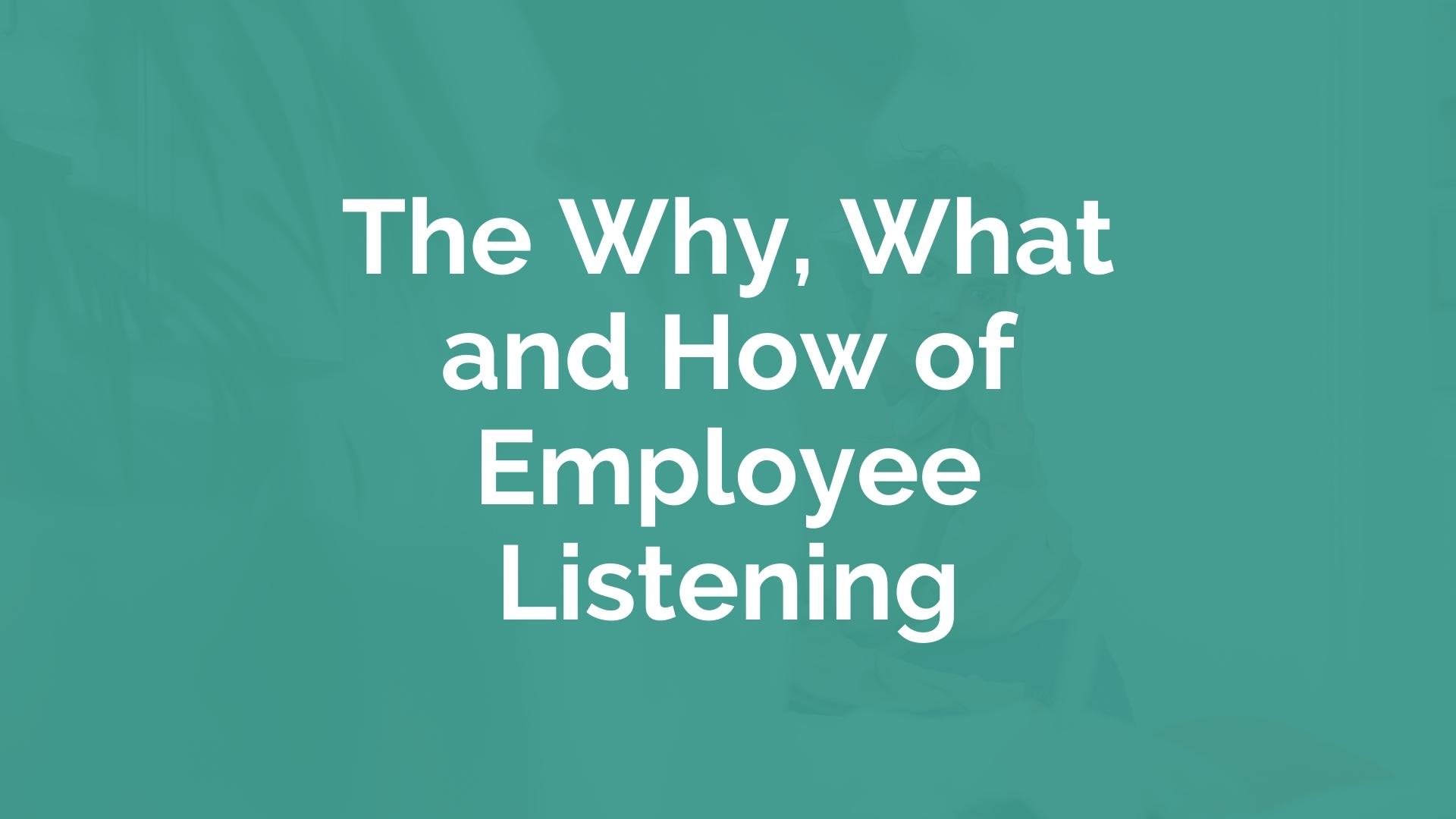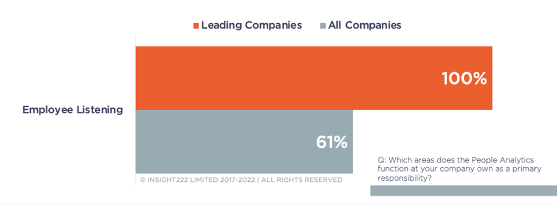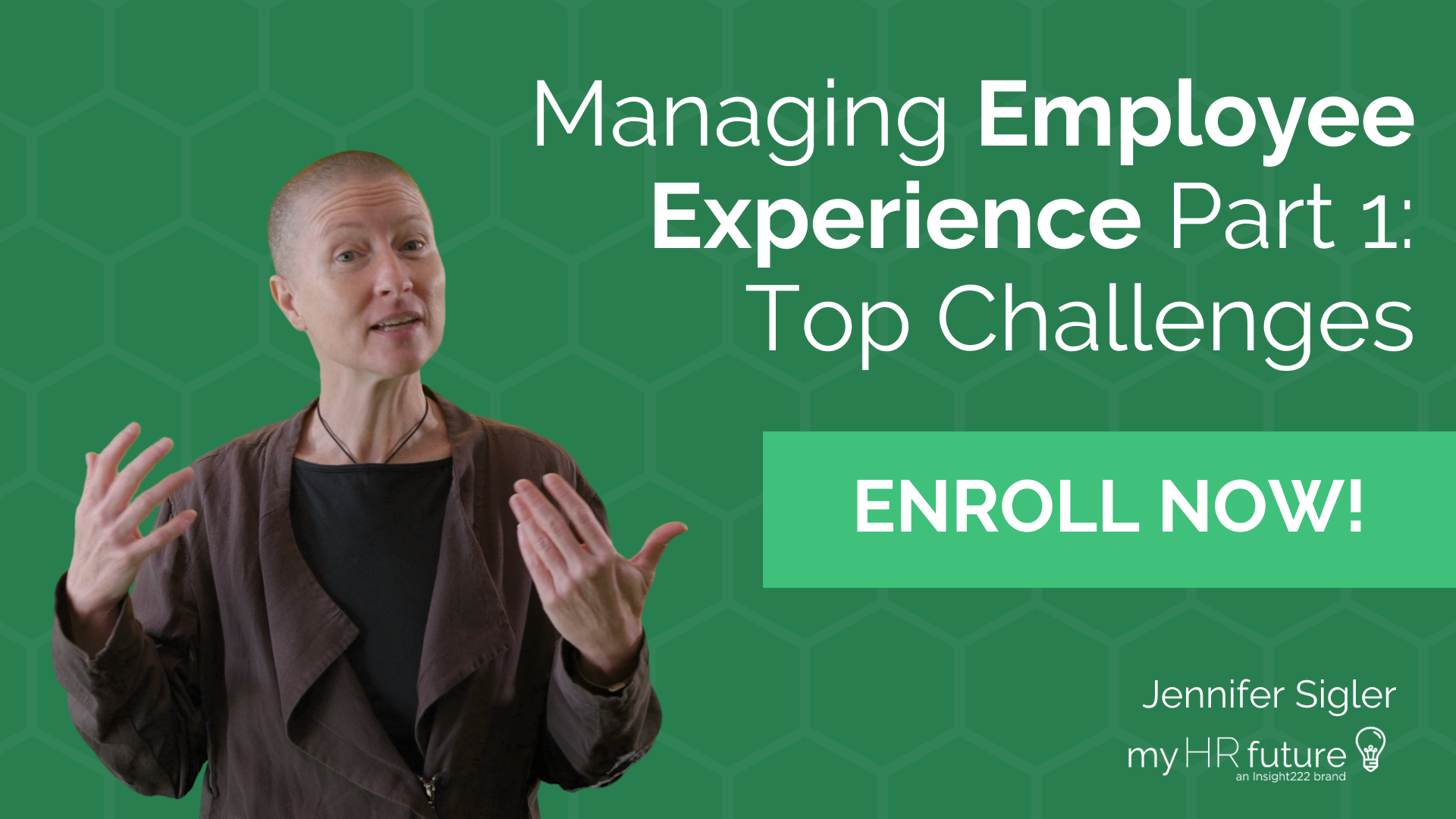The Why, What and How of Employee Listening
High employee engagement does not necessarily mean that employees are happy, satisfied, and motivated at work. In fact, research suggests that 18% of organisations have high engagement along high turnover. This raises the pertinent questions: Are we really listening to our employees? Are we creating workforce experiences that truly resonate with them? Or are we just focused on creating a facade of engagement?
As Jennifer Sigler, Head of Research at TI People, FOUNT Global, Inc., and the Exchange, highlights in her myHRfuture course, Managing Employee Experience Part 1: Top Challenges, organisations face multiple challenges with their EX. These are notably related to measuring or coordinating work within the organisation.
This article will focus on the measurement piece, precisely employee listening and its foundations: the why, what, and how of employee listening.
What is Employee Listening?
There may be many different definitions of employee listening, but at its core, employee listening is the process of collecting, analysing, and sharing feedback from employees. Employee listening is usually part of a people analytics function but can also be found within other human resources functions like employee experience or talent management. Employee listening offers many opportunities to add value to the business, and many companies are taking advantage of that opportunity.
Most companies we work with at Insight222 say employee listening is a priority and part of their overall people analytics strategy. Our yearly research has supported this. According to our 2021 People Analytics Trends study, 45% of companies say employee listening is one of the top areas where people analytics adds value.
Similarly, both our 2022 People Analytics Trends Survey and 2023 People Analytics Trends Report confirmed that employee listening and workforce experience continue to be among the top five areas where people analytics adds the most business value.
However, no matter where your organization is on their employee listening journey, establishing the right foundations for a true culture of continuous listening is critical. This is where understanding why, what and how comes into play.
Why: Crafting an Actionable Employee Listening Strategy
You may wonder why the "why" is important to begin with. The short reason - to make sure that what you do will provide value. When it comes to employee listening, you need to first know what is important to the business. What questions need answers?
What problems need solutions? You want to be sure that you don't fall into the trap of producing work that, while it may be interesting, is not really adding value to the business.
Think beautiful survey dashboards that never get used or impressive advanced analytics projects that don't land with executives. Employee listening can end up being one of those things we do just because we think we should. Without a clear purpose, a company can quickly squander precious resources on going through the listening motions without realizing any benefit.
That's why you start with the "why." Finding out what the business wants to know about employees is key to uncovering meaningful voice of employee insights.
Why are we sending out this survey? Why are we collecting passive data? Why are we creating an always-on channel? Fully answering these questions requires a coupling of 1) perspective and context straight from the business and 2) expert guidance from people analytics who can then ideate hypotheses to test that can light the spark of action.
Pro Tip: Doing this step well can help you avoid the pitfall of asking questions about things you can't change.
What: Move Beyond Surveys with Multi-Channel Listening
Quoting Jeniffer from her Managing Employee Experience Part 1: Top Challenges course:
"The challenge is getting 360 degree data on a specific experience. Because some of the people that I need to hear from are users or recipients or customers of that experience. While others are owners or managers. And that means asking them different questions. Are your surveys designed to do that? Most people’s aren't.”
There's a lot to unpack there; at the core, it is about understanding what questions you need answered by both employee groups. Ask yourself, what do we want to know? What is the business problem that we are trying to solve? This eludes back to your "why," as it's likely that what you want to know is tied directly to delivering a business outcome. The "what" should be measurable and actionable but also aligned with the company's overall purpose and values. Other questions you want to ask yourself are:
What channels do you need to solicit that feedback?
The answer to this question doesn't stop at a list of various surveys. Leading companies in people analytics and employee listening use a multi-channel listening strategy to capture the employee's voice.
One financial software firm that Insight222 partners with has many avenues for employee listening, allowing the insights from each listening frequency to influence action at the moment. They have created a channel called "Ears-On-The-Ground", a weekly meeting of nominated HR Champions in which they discuss the feedback, concerns, suggestions, etc., they've heard that week from employees. Insights gathered from this network revealed employee concerns around meeting overload and well-being. Based on this feedback, the company instituted "Recharge Days," scheduled days for all employees to fully disconnect from work.
Another channel this firm utilises is data from its HR employee service centre. Analysing ticket data from employee questions revealed a lack of understanding of virtual working policies and leave benefits. This led to a refresh of policies around equipment reimbursement for virtual work and a more generous sick leave and family support leave policy.
What technology do you need to collect the data and share back insights?
When designing the feedback mechanisms, it's important to maintain an employee-centred mindset. Consider what the easiest way is for an employee to share the type of feedback you are looking for. You should aim to leverage technology in such a way that feedback collection can happen seamlessly during the employee's day-to-day work. This is especially important for soliciting new ideas for innovation as well as feedback on the customer experience. You don't want to make employees wait for the semiannual pulse survey to share an idea for a more efficient process or a novel approach to making customers more satisfied. Melissa Arronte, Employee Experience Practice Lead at Medallia, shared her perspective on this subject on our Digital HR Leader's podcast:
"We are seeing many more companies adopting [an] approach of meeting employees where they are instead of having employees chase an email somewhere or line up to use a kiosk."
She mentioned many ways to make providing in-the-moment feedback as easy as possible for employees. QR codes allow for quick access to a short survey straight from the employee's phone, but perhaps even better is what Melissa calls a "digital survey", in which the survey is embedded in something like the company's timekeeping system or even the point-of-sale software. Another suggestion Melissa shares for improving the employee experience of providing feedback is keeping the structured questions to a minimum.
We are fortunate enough to incorporate AI and machine learning technologies to help us gather insights even faster and more accurately than ever before. Take, for instance, Genpact, a global professional services firm. By adeptly integrating advanced AI methodologies, they can pinpoint specific sentiments and issues pertinent to employees at different career lifecycles. The AI tool sends personalized surveys to each employee during different career stages based on the previous responses to drive more in-depth and relevant insights. This holistic understanding of the employee lifecycle is a powerful way to deliver better employee experiences.
In his discussion regarding bridging the gap between customer experience (CX) and employee experience (EX), Kaz Hassan, Employee Experience Lead at Unily, provides a great analogy of this in practice:
"If you think about what are the companies that are having the biggest impact on customers and delighting them, they're the companies like Apple and Amazon, and they don't send you a once-a-year survey to ask you how they're doing. They map out the customer journey and they understand all these different touch points, how did we do here; what was the packaging like; did we make you happy; was the product what you expected? But there are synergies there that people need to understand, which is understand specifically what's working, what's not working. And yes, the once-a-year survey is helpful to help you benchmark, are we going in the right direction year on year?
But if you're thinking of the average employee and what's going to help them stay in the role, they are typically the little things that they want to see change quickly and implement it."
Segmenting your employees into different personas can also help with your listening strategy, as you can tailor surveys, questions, discussions, and other feedback channels to the experience of each group. But as Jenifer highlights in her course, Managing Employee Experience Part 2: Tackling the Challenges:
"Zoom in on different segments. Ask them questions tailored to their experience, and work with their answers to fix their problems in a targeted way. Segmenting your employees into different personas can also help with your listening strategy, as you can tailor surveys, questions, discussions, and other feedback channels to the experience of each group."
It is important to note, here, that when segmenting employees into personas, you must also understand that employees within specific teams, seniority levels, and cultures within your organization may have unique experiences.
Passive data collection methods can uncover truths that may not be visible through surveys. For instance, tracking employee engagement and sentiment through company communication platforms like Slack or Microsoft Teams can provide valuable insights into how employees interact with each other and the organization.
Forward-thinking companies not only rely on direct feedback through surveys but also enhance their understanding of employee attitudes by integrating passive data into their analyses. This data can unveil real-time behavioural insights, such as the correlation between employees who highly recommend their company and their regular one-on-one meetings with managers.
However, ensuring that such methods don't inadvertently discourage honesty is crucial. Employees might resort to alternative communication platforms like WhatsApp for candid discussions about work, thus skewing the data collected from official channels. Nick Lynn highlights the importance of broadening the data collection net to capture a fuller picture of employee sentiment. He advises:
Use diverse data sources, including insights from Glassdoor, feedback from recruiters, external partners, and alumni. This approach helps in capturing a broader spectrum of employee experiences and sentiments.
Triangulate different research approaches and avoid becoming overly reliant on a single method. It's imperative to regularly innovate and adapt your feedback mechanisms to ensure they remain relevant and effective.
Commission trusted independent parties to conduct parts of the research, particularly those with specialized expertise in areas of keen interest. External agencies can offer an unbiased perspective and may help uncover insights that internal efforts might miss.
By implementing these strategies, organisations can ensure they are not just capturing the surface-level employee feedback but are genuinely understanding the depth and breadth of employee experiences and attitudes.
How: Taking Action From Feedback
Ideally, action planning based on employee feedback should take place at all levels of the organisation and continuously. But in reality, some organizations are still only requiring action planning of higher-level leaders and attaching action planning activities to an annual cycle that doesn't include any follow-up. To move towards a highly adopted and continuous action planning model, you need to:
Set clear expectations with HR and people leaders. Be explicit about what their roles are.
Link employee listening data with key business and talent outcomes. Showing leaders the power of employee listening and the potential impact they can have by connecting these dots for them is critical for building credibility with the business.
Create tools and resources for leaders to set them up for success. Help them have tough conversations and support them in navigating change.
Acknowledge what you've heard even if you can't act on it quite yet! This is how you build trust and credibility for listening programs, which is key to ongoing success.
Close the feedback loop with employees at multiple levels. Managers have a responsibility to their teams, but be sure you acknowledge what you've heard at the division, function, or even enterprise level as well.
As Jenifer highlights in her myHRfuture course, Managing Employee Experience Part 2: Tackling the Challenges, all this revolves around ensuring that ownership is dispersed across the organisation.
"With most people data, HR designs the collection instrument, meaning the survey or interview guide, collects the data, analyses it, then distributed various statistical reports to various business leaders and managers.
If all I get is a report, I don't manage that data. And if that data isn't helpful to me (as we have seen most business leaders say that most EX is not), then I don't have a simply direct way to adjust the collection instrument to get the data I need. Or to collect data more frequently if I want, or to analyze the data in a different way.
That way, business leaders manage their own slice of the data and EX, with HR still there to support and consult. This will not only get buy-in from business leaders but also provide more granular understandings that serve each business unit and unique EX."
Some Pitfalls to Avoid
Don't sacrifice the right question on the altar of the benchmark. Getting too caught up in using survey questions that other companies use or that your company has used in the past is a risk that you will miss getting the right feedback now. There is no one-size-fits-all to employee listening.
Don't ask about things you can't change. This is a great way to frustrate your employees and make them lose trust in the employee listening program. Making sure that you really understand the "why" for your business leaders can help you avoid this pitfall!
Don't underestimate the change management needed to do continuous listening well. Employees, people managers, HR, and executives all need to be supported in building the muscles to make listening activities easy and automatic.
Don't assume more data is always better. More volume does not automatically translate to more value. Some leaders may try to discount employee feedback when they feel a certain response threshold hasn't been met. But this concern can be successfully addressed when you create a multi-channel listening strategy where employees aren't chased to share their voice, but enabled to speak up when they have something on their mind.
Next Steps
To either get started or to upgrade your employee listening program, Insight222 has two resources available. First, a curated collection of expert practitioner materials in the myHRfuture Academy. Second, our Insight222 annual co-creation on employee listening. The co-creation brings together over 50 global companies over the course of this year to explore the topic, share experiences, and create solutions via a series of live and virtual meetings. To make use of either resource contact us.
ABOUT THE AUTHOR
Dirk Petersen is a renowned expert in HR strategy, organisational change, digital transformation, and how analytics affect HR communities and those they serve. After his MBA at Harvard Business School, Dirk spent many years serving leading organisations at the Corporate Executive Board (CEB). From there he served as a HR Business Partner with the World Bank. Since then he's helped leaders better understand and strategise around how workforce analytics impacts careers, innovation, operational effectiveness, and executive decision-making.








